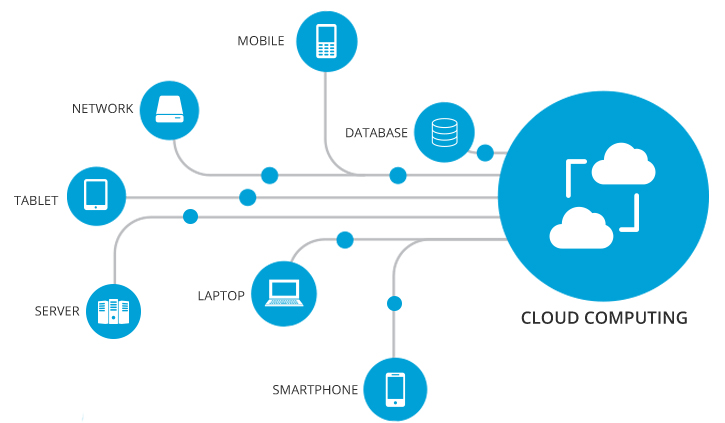Simplify Your Facilities With Cloud Solutions
As businesses navigate the ever-evolving landscape of modern technology and data management, the role of cloud services in streamlining facilities has actually come to be significantly popular. How can services effectively navigate this change and genuinely open the capacity of cloud solutions for simplifying their framework?
Benefits of Cloud Provider
Cloud solutions use a structured approach to managing IT facilities, giving businesses with cost-efficiency, versatility, and scalability. One of the essential advantages of cloud solutions is the scalability they supply.
In addition, cloud services get rid of the need for businesses to buy costly software and hardware. This cost-efficiency is a significant advantage, particularly for little to medium-sized enterprises seeking to decrease upfront prices. By utilizing cloud services, services can access top notch IT sources without the hefty rate tag linked with traditional infrastructure configurations.
Additionally, cloud solutions offer organizations with the flexibility to access their information and applications from anywhere with a web link. This level of availability boosts collaboration amongst teams, allows remote job, and enhances general performance. The versatility used by cloud services encourages businesses to adapt swiftly to transforming market conditions and customer demands.
Price Financial Savings and Scalability
Along with the functional benefits highlighted earlier, the combination of cloud services right into a company's facilities comes up with substantial expense financial savings and boosted scalability. Cloud solutions use a pay-as-you-go design, allowing businesses to scale sources up or down based on current requirements, therefore avoiding the prices linked with keeping excess capacity. This versatility allows business to adjust promptly to changing demands without incurring unnecessary expenditures.
In addition, cloud solutions remove the need for upfront investments in software and hardware, lowering capital expenses. Operating budget are also decreased as companies no longer need to handle and keep physical web servers, resulting in lower energy intake and IT staffing expenses. Furthermore, cloud solutions provide automatic updates and upkeep, making certain that the framework continues to be safe and secure and current without calling for manual treatments.
Improved Safety Actions
Executing rigorous protection procedures is vital when integrating cloud services right into a firm's framework to ensure and safeguard delicate data conformity with market policies. Cloud company supply enhanced safety and security attributes such as data encryption, firewall program security, and multi-factor authentication to minimize cybersecurity dangers. Security assists safeguard data both at remainder and en route, making certain that just authorized users can access delicate details. Firewall programs function as a barrier between internal networks and outside risks, surveillance and managing outgoing and inbound network traffic. Multi-factor authentication includes an extra layer of safety by needing users to offer multiple types of confirmation before accessing the cloud services.
Furthermore, regular security audits and conformity evaluations aid recognize vulnerabilities and ensure adherence to market requirements. Business can likewise benefit from features like automatic safety and security updates and real-time risk monitoring given by cloud solution carriers. By prioritizing protection steps and remaining proactive in dealing with possible risks, businesses can with confidence utilize cloud solutions while protecting their important data from unauthorized gain access to or violations.
Transitioning to Cloud Infrastructure
To effectively integrate cloud services into a company's infrastructure, an organized approach that addresses the shift in the direction of cloud-based solutions is important. Transitioning to shadow infrastructure involves mindful planning and execution to ensure a smooth migration process. The first action is to assess the present infrastructure and figure out which applications and systems are appropriate for migration to the cloud. This examination ought to think about factors such as data sensitivity, conformity requirements, and efficiency demands.
Once the analysis is full, a migration approach must be created. This strategy must describe the timeline, sources, and next page obligations for relocating each component to the cloud. It is essential to connect this plan plainly to all stakeholders to ensure placement and reduce disturbances throughout the shift.
During the migration monitoring, testing and procedure are critical to determine and attend to any issues quickly. Routine checkpoints ought to be developed to track progression and make essential modifications. Additionally, training for employees on making use of cloud solutions need to be provided to make sure a successful change and take full advantage of the benefits of the brand-new framework.
Finest Practices for Cloud Adoption
Effective fostering of cloud services depends upon the tactical positioning of service purposes with technical capacities and organizational preparedness. To guarantee a smooth change to the cloud, companies must start by conducting a detailed evaluation of their present facilities and recognizing which workloads are best fit for cloud migration. It is essential to involve essential stakeholders from various departments in the decision-making process to acquire buy-in and deal with any type of problems early on.
An additional best method for cloud adoption is to focus on protection and conformity. Organizations has to thoroughly evaluate the safety measures supplied by cloud provider and make sure that their information is shielded according to market criteria and regulative requirements. Applying durable data encryption, access controls, and regular protection audits can help reduce risks linked with cloud adoption.

Verdict

As businesses navigate the ever-evolving landscape of modern technology and information management, the function of cloud services in streamlining framework has actually become progressively prominent - universal cloud Service. Just how can organizations effectively navigate this transition and really open the potential of cloud solutions for streamlining their facilities?
Cloud solutions offer learn this here now a streamlined strategy to handling IT infrastructure, providing companies with scalability, adaptability, and cost-efficiency. By making use of cloud solutions, companies can access premium IT sources without the hefty cost tag connected with conventional infrastructure setups.
To ensure a smooth transition to the cloud, companies must begin by carrying out a thorough evaluation of their existing infrastructure and determining which workloads are best suited for cloud migration.